Thai Puppetry
Back to Articles about Thai Culture
- In August 1996, the Thailand Cultural Centre, Office of the National Culture Commission of the Ministry of Education organised the INTERNATIONAL PUPPET FESTIVAL in honour of His Majesty the King’s Golden Jubilee Celebrations. This article introduces Thai puppetry as it exists today. - Editor.
TYPES OF PUPPETS
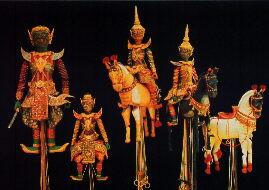
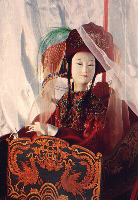
Obsolete HUN LUANG royal puppets and exquisitely made modern HUN KRABOK
Thai puppetry includes both the two-dimensional puppets which are presented in shadow play both in front of and behind a brightly lit muslin screen, known by the genre name of SHADOW PUPPETS, and three-dimensional FIGURE PUPPETS in stage settings. The shadow play figures are collectively known as NANG (projected image), while the figure puppets are known as HUN (modelling).
SHADOW PLAY PUPPETS
Shadow puppetry is the older art form. There are two groups : Nang Yai (large shadow puppets) and Nang Talung (jointed shadow puppets). The NANG YAI is considered a classical art form, an originator of the KHON classical masked dance. The puppet figure is quite large, sometimes standing 2 meters tall. It is made of leather, pierced with a figurative and decorative pattern to depict a particular scene in the story. Light bamboo rods are attached to the figure so that the puppeteer can hold it aloft in front of or behind a screen. The puppeteer actually dances with the puppet to musical accompaniment. The story is told with a singing and recitative voice, and ever changing puppet figures. The flickering light from a live bonfire, using smoke-free dried coconut shells as fuel, helps to bring the puppet to life. Some figures are brightly coloured for day time or half-light use.
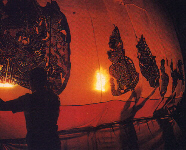
NANG YAI in action - flickering flames and billowing screen render lifelike movement to the figures.
The NANG TALUNG puppet figure is much smaller and is handled by a seated puppeteer. This art form is considered a folk art, depicting folk tales with a raucous sense of humour which often lampoons current social or political situations. The figure is fixed to a single stick handle. Thin rods are fixed to the hands and the arms are jointed at the shoulder, elbow and wrist. The puppeteer makes expressive movements while speaking the part. In traditional Nang Talung, the whole show is presented by one man, the Master Puppeteer, who is honoured with the title “nang” in front of his personal name. There is a musical accompaniment, using the folk ensemble of oboe, drums, gongs and clappers. This art form has changed through the ages and according to regional preferences. In the North-eastern Region of Thailand, it has become known as NANG PRAMOTHAI in which many puppeteers take part at once. Nang Talung, indigenous of the Southern Region, has undergone some changes such as incorporating western musical instruments and stage effects.
FIGURE PUPPETS
Two kinds of puppets are being performed on the traditional Thai stage. The HUN KRABOK, half-figure puppet, and the HUN LAKORN LEK, full-figure puppet. Other kinds known as HUN LUANG and HUN LAKORN exist as beautiful museum pieces, but are no longer used.
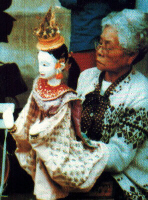
Puppet Mistress Chuen Sakulkaew demonstrates the HUN KRABOK.
HUN KRABOK may be loosely translated as “pole puppet”. The name derives from the use of a short length of pole or pipe, traditionally bamboo but now replaced with other materials, as the puppet’s main frame. Only the top half, head and headgear of the puppet is shown. Each hand is connected to thin rods for manipulation.
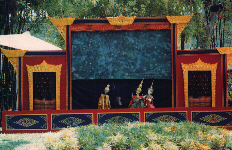
A modern version of the traditional HUN KRABOK stage
The puppet stage has an ornate backdrop, always flanked by doors through which the puppets make their entrances and exits. The bottom edge of the backdrop has a translucent screen which conceals the working puppeteer, and a sight screen stands some 50 cm. to the front of the backdrop. The puppeteer holds a puppet’s body pole in his left hand and manipulates rods connected to its hands with the right hand. The movements mimic dance gestures of the classical dance-drama. A musical ensemble and singer sit back-stage. Speaking parts are by the working puppeteer.
HUN LAKORN LEK is a recent revival of an art form which had actually died out. Master Puppeteer Sakorn Yangkeowsod re-invented a full-figure puppet show with much development. His large troupe of family members now stage puppets which have sophisticated (and secret) joints, capable of lifelike gestures such as pointing fingers and articulated waist.

Puppet Master Sakorn Yangkeowsod directs a
performance
from back stage surrounded by his HUN LAKORN LEK.
The puppets are fully dressed for their roles exactly representing human actors. Each major puppet is handled by three puppeteers, one for the body and right arm, one for the left arm and one for the legs and feet. The team actually dance as they perform and often do so in front of the sight screen in full view of the audience.
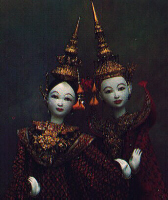
Lifelike imagery is the ideal.
- Photographs : INTERNATIONAL PUPPET FESTIVAL souvenir programme
published by the Thailand Cultural Centre, August 1996, and RATCHABURI
published by Ratchaburi Province, 1996.
Back to Articles about Thai Culture
|
||||||